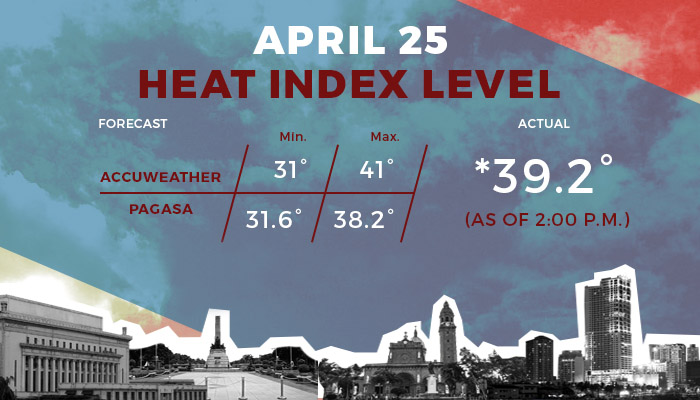
Summer season is definitely upon the Philippines as the heat index of Manila reaches extreme levels.
The Facebook page of Young Earth Scientists’ Society released a week-long forecast of the maximum heat index in Manila that would reportedly reach 41 degrees Celsius.
The data was initially released by AccuWeather, an American company that provides commercial weather forecasting services worldwide.
The hottest days are supposed to be on April 24, 25 and 29, with heat index levels reaching “danger” state.
The page advised people to keep themselves hydrated the entire week.
State meteorologists at PAGASA recently warned that the weather would be warmer due to the “ridge of high-pressure area.” This would affect Northern and Central Luzon, bringing in warm and dry conditions with isolated rain showers all over.
The state weather bureau cited that a heat index is in “extreme caution” level when the temperature is from 31 to 41 degrees Celsius.
It would reach “dangerous” level when it goes from 41 to 54 degrees Celsius.

The differences in the forecasts are attributed to the unpredictable nature of the weather, especially at the time the forecast was made.
According to Adam Morgan, a senior meteorologist at Australia’s Bureau of Meteorology, “the weather is an inexact science.”
He noted that although meteorologists try to gather the most accurate reports, nature can still behave in an unexpected manner.
Bring in the heat
PAG-ASA defines heat index as the “human discomfort index that ‘gives’ apparent temperature of what human perceive or feel as the temperature affecting their body.”
It is the temperature which people feel, which is different from the actual temperature of the environment they are in.
A high temperature with a relatively high humidity would give a high heat index level.
PAGASA stated that the country would experience an overall heat index level of “extreme caution” from April 25 to 29.

PAGASA reported that Manila would have heat index levels reaching “extreme caution” within the week. (Philstar/File photo)
“Extreme caution” is when the temperature reaches 32 to 41 degrees Celsius. The body may possibly experience cramps and exhaustion due to heat. People might also experience heat stroke if cramps and exhaustion persist.
Meanwhile, a “dangerous” type of heat level index is experienced when the temperature rises from 41 to 54 degrees Celsius.
The body would most likely feel heat cramps and exhaustion, as well as heat stroke.
What does this mean?
In the comments section of the post, Filipinos said they have recently been feeling an uncomfortable warmth.
Matthew Cramer, researcher at the Institute for Exercise and Environmental Medicine, explained the body undergoes stages when it experiences extreme heat.
He said in Business Insider, “The first thing that will happen is that your skin starts to heat up.”
Then the person would perspire in an effort to keep the body cool. If the temperature continues to increase, the body might no longer be able to produce sweat.
This is when dizziness, feelings of confusion and loss of consciousness occur. The body will eventually feel muscle cramps and swelling. After which, the person would become at risk of organ damage or “cooked” organs. — Infographic by Uela Badayos









